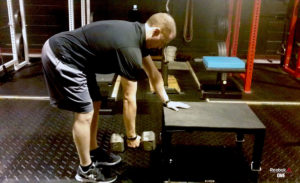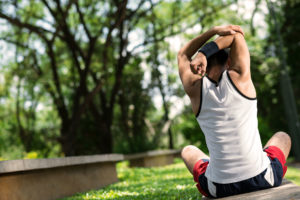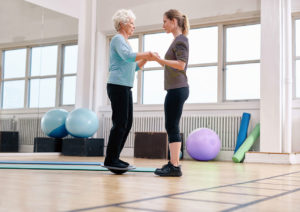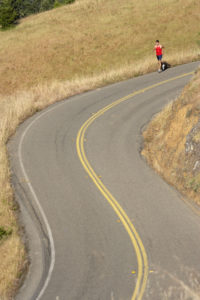Safety
Is There a Right or Wrong Way to Squat?
“Hey, keep your knees behind your toes when you squat!” “Deep squats are bad
for the knees!” “My doctor told me I should not squat anymore.” “You
should never let the knees cave in or out during a squat.” Chances are
you’ve heard this advice and maybe even given it to your clients. I know
that for many years in my career I’ve been guilty of making similar
recommendations to clients from all walks of life. The problem is, where
Row the Right Way
We can all assume that we know how to row, but if you’re serious about getting strong while keeping your shoulders healthy, you may just want to read this. Mike Robertson, ReebokONE Expert Contributor and President of Robertson Training Systems, breaks down the proper way to row.
Chronic Pain in Fitness Professionals
An Objective Eye
It can be difficult to take a step back and be objective when it comes to your own health. Katy Bowman, MS, director of the Restorative Exercise Institute in Ventura, California, and author
of Move Your DNA: Restore Your Health Through Natural Movement (Propriometrics Press 2014), suggests you write down
the following:
Profiles of Pain and Perseverance
In February 2006, Danny Strong was on top of the world. After years of working as a gym manager, he had opened his own personal training gym, making his dream a reality. The husband and father was also eager to welcome a second child into the family. A month after receiving the keys to his new facility, he took his family on a trip to visit his godmother. While on the road, Strong lost control of his vehicle and was hit by a tractor-trailer traveling at full speed. His pregnant wife, Sandra Urbano Strong, was killed instantly.
Fit to Travel
Whether we’re vacationing with our family or heading to the 2015 IDEA World Fitness ConventionTM with 12,000 other fitness enthusiasts, it can be challenging to stay fit when we’re on the road. Even the healthiest exercise professionals can get caught off-guard with aches, pains, stress and guilt that prevent us from having fun and functioning at our best.
If travel throws the fittest of us off track, imagine what it does to everyone else.
Stretching For Men
Many men struggle with inflexibility and diminished joint range of motion, especially as they age. Hip tightness, for example, can hinder athletic performance and possibly lead to various injuries. Unfortunately, stretching often takes a back seat to cardiovascular and strength training.
Pregnant Instructor FAQs
Many years ago, while I was pregnant with my second child, something happened that I hope no other group fitness instructor goes through. As I was driving to teach class,…
Taking a Tech Break
Cellphones, computers, tablets. All of these are important tools that help you to run a successful fitness business. But technology can seep into every moment of your life and take over. Do you need to step away from email or give your smartphone a rest from time to time? Discover why you’ll be a better entrepreneur if you explore options for setting limits around technology and just say no to it some of the time.
Five Benefits of Eccentric Exercise
Not everyone likes to focus on eccentric contractions, but this style of training deserves more attention because it may be a “secret weapon” for creating healthier joints and a long, lean body. Research reveals the perks for newcomers and well-trained athletes.
Fall Prevention Training for Seniors
It appears there is a growing need for seniors to engage in fall prevention. A recent report found a significant increase in falls from 1998 to 2010.
Researchers looked at data from the Health and Retirement Study, which is an interview-based report. Among individuals aged 65 and older, the percentage who had experienced at least one fall in the 2 years prior to the interview rose from 28.2% to 36.3%—a relative increase of close to 30%. The researchers were surprised to learn that the increase was most marked among the younger people studied (those closer to 65).
7 Possible Causes of Overtraining
Conducting primary research studies on the causes of overtraining is difficult because it’s unethical to induce overtraining syndrome, which can damage a person’s performance for months. Kreher and Schwartz (2012) reviewed previously published overtraining research and summarized seven hypotheses (see Figure 5) for mechanisms that cause overtraining syndrome.
HYPOTHESIS #1: AUTONOMIC NERVOUS SYSTEM IMBALANCE
Frightening Bone Health Statistics Among Men
Osteoporosis is typically thought of as a “woman’s disease.” But a recent report published by the International Osteoporosis Foundation warns that, in certain circumstances, men may be at greater risk than women for potentially fatal bone health–related maladies.
Ready, Set…Mud!
Does the idea of running a mud race appeal to you? Anyone who signs up for an obstacle challenge—whether for the fun, the teamwork (or, sometimes, the beer!)— will soon confront the substantial physical and mental demands of these races.
Making The Most Of Outdoor Fitness
Adding outdoor activities to your fitness programming can effectively increase the overall health and well-being of your clients. Use these tips to find the right partners to meet your goals and to keep your clients safe while enjoying the great outdoors.
Risk Management
Preparation. Mother nature is ultimately in charge in the outdoors. Minimize risk with an operation plan that addresses the following:
Training for a Marathon
Whether you want to run a marathon for the thrill of it, to cross it off your bucket list or to qualify for the prestigious Boston Marathon, it all starts with a single step. When you put together enough steps to cover 26.2 miles, you become a marathoner!
So how do you run a marathon? Jason Karp, PhD, the 2011 IDEA Personal Trainer of the Year and author of Running a Marathon for Dummies, gives you strategies below.
Mileage
Recovery: The Rest of the Story
The health and fitness world confronts a complex paradox. Exercise causes consternation and elation, angst and joy. It can prevent—and lead to—illness and injury. Workouts can keep you out of a hospital and put you into one.
Novice Marathoners Beware
According to www.findmymarathon.com, 529,435 people finished marathons in the United States and Canada in 2012. Although marathon running is a pop- ular sport, recent research warns that “amateur runners” who participate may increase their cardiac risk.
Movement Errors and Contraindications for the Shoulder
Accurate data are needed to determine which corrective strategies a client needs. A trained, experienced corrective exercise specialist will also be able to pinpoint movement errors. Repetition and coaching will sharpen assessment skills.
“Have you trained any clients who have undergone gastric bypass surgery? Do you have any special precautions or suggestions?”
Working with clients who have had gastric bypass surgery requires some extra caution and attention. I first met one such client about a year after her surgery. I asked her a ton of questions because I wanted to understand her motivation, why she decided to have the surgery, what her experience had been living with the result, what her restrictions and limitations were and how she was working within those limitations—her successes and challenges. One of the things I’ve learned about fitness and clients is that everything stems from their thinking process.
Heart Arrhythmias: An Exercise Professional’s Primer
The heart does remarkable work. Roughly the size of a human fist, the heart pumps blood every second of every day, delivering nutrients and oxygen to organs and tissues, and sending waste to filters in the kidneys, liver and lungs.
Yet not every heart works well. A healthy heart relies on a self-generating electrical signaling system to keep it pumping at the right pace; heart maladies that disrupt the signals can dramatically impact a client’s health. Collectively, we call these maladies heart arrhythmias.


















